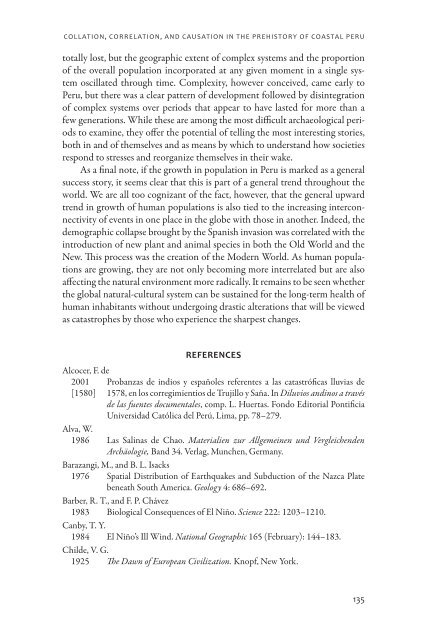free download - University Press of Colorado
free download - University Press of Colorado
free download - University Press of Colorado
You also want an ePaper? Increase the reach of your titles
YUMPU automatically turns print PDFs into web optimized ePapers that Google loves.
Collation, Correlation, and Causation in the Prehistory <strong>of</strong> Coastal Peru<br />
totally lost, but the geographic extent <strong>of</strong> complex systems and the proportion<br />
<strong>of</strong> the overall population incorporated at any given moment in a single system<br />
oscillated through time. Complexity, however conceived, came early to<br />
Peru, but there was a clear pattern <strong>of</strong> development followed by disintegration<br />
<strong>of</strong> complex systems over periods that appear to have lasted for more than a<br />
few generations. While these are among the most difficult archaeological periods<br />
to examine, they <strong>of</strong>fer the potential <strong>of</strong> telling the most interesting stories,<br />
both in and <strong>of</strong> themselves and as means by which to understand how societies<br />
respond to stresses and reorganize themselves in their wake.<br />
As a final note, if the growth in population in Peru is marked as a general<br />
success story, it seems clear that this is part <strong>of</strong> a general trend throughout the<br />
world. We are all too cognizant <strong>of</strong> the fact, however, that the general upward<br />
trend in growth <strong>of</strong> human populations is also tied to the increasing interconnectivity<br />
<strong>of</strong> events in one place in the globe with those in another. Indeed, the<br />
demographic collapse brought by the Spanish invasion was correlated with the<br />
introduction <strong>of</strong> new plant and animal species in both the Old World and the<br />
New. This process was the creation <strong>of</strong> the Modern World. As human populations<br />
are growing, they are not only becoming more interrelated but are also<br />
affecting the natural environment more radically. It remains to be seen whether<br />
the global natural-cultural system can be sustained for the long-term health <strong>of</strong><br />
human inhabitants without undergoing drastic alterations that will be viewed<br />
as catastrophes by those who experience the sharpest changes.<br />
References<br />
Alcocer, F. de<br />
2001 Probanzas de indios y españoles referentes a las catastróficas lluvias de<br />
[1580] 1578, en los corregimientios de Trujillo y Saña. In Diluvios andinos a través<br />
de las fuentes documentales, comp. L. Huertas. Fondo Editorial Pontificia<br />
Universidad Católica del Perú, Lima, pp. 78–279.<br />
Alva, W.<br />
1986 Las Salinas de Chao. Materialien zur Allgemeinen und Vergleichenden<br />
Archäologie, Band 34. Verlag, Munchen, Germany.<br />
Barazangi, M., and B. L. Isacks<br />
1976 Spatial Distribution <strong>of</strong> Earthquakes and Subduction <strong>of</strong> the Nazca Plate<br />
beneath South America. Geology 4: 686–692.<br />
Barber, R. T., and F. P. Chávez<br />
1983 Biological Consequences <strong>of</strong> El Niño. Science 222: 1203–1210.<br />
Canby, T. Y.<br />
1984 El Niño’s Ill Wind. National Geographic 165 (February): 144–183.<br />
Childe, V. G.<br />
1925 The Dawn <strong>of</strong> European Civilization. Knopf, New York.<br />
135





